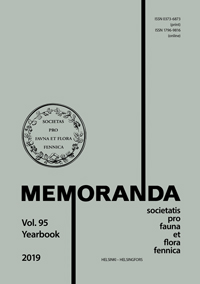The Hawthorn Moth Scythropia crataegella (Lepidoptera: Yponomeutidae) in Mariehamn, Åland Islands, in 2010–2018
Abstract
The Hawthorn Moth Scythropia crataegella (Linnæus, 1767), an ermine moth of the family Yponomeutidae, is protected and declared as a species with strict protection according to the nature conservancy law of the Åland Islands. The species was found in 26 localities in the town of Mariehamn between 2010 and 2018. The only food plant of S. crataegella in the Åland Islands, previous to the studies of the author, was Malus sylvestris. The food plants of the larvae of S. crataegella in Mariehamn have been shrubs of four cultivated Cotoneaster species (taxa) and shrubs and saplings of two cultivated and one or two domestic Crataegus species. Of these, Cotoneaster lucidus (11 localities) and C. horizontalis (5 localities) are the most common food plants. Of these, Cotoneaster lucidus and Crataegus grayana are very common as cultivated hedge shrubs in Mariehamn. Crataegus grayana, has however, been found as a food plant in one locality only.
The exposition of the food plants seems to have some influence on the location of the infestations with the most common exposition towards the east (ten localities). West and south expositions have been observed in eight and five localities, respectively.
As the bulk of the localities are in cultivated hedges or shrubs of the food plants, the shearing of the hedges hampers the life of S. crataegella. Although S. crataegella is a protected species in the Åland Islands, it can be a garden pest. It is therefore understandable, but not recommended, if owners of hedges are cutting damaged parts of the shrubs.
As a bivoltine species, C. crataegella have been found regularly as generation I in June – July and again as generation II in August – September, always on the same shrub. However, some irregularities have been observed. In one locality nothing was seen of generation I on June 18, 2018, but four small silk webs with fairly small larvae of generation II were observed on August 14, 2018. In another locality, a small silk web with a few larvae and pupae of generation I was observed on June 21, 2016, but nothing of S. crataegella could be found in August the same year. However, a small silk web with a few larvae and pupae of generation I was observed on June 24, 2017. Possibly, all eggs do not hatch at the same time; some of them can perhaps survive till the next year.
The studies of S. crataegella in 2010–2018 show that the species is fairly common in Mariehamn. If all streets and gardens should be searched for S. crataegella infestations, the number of localities could most probably be considerably increased.




